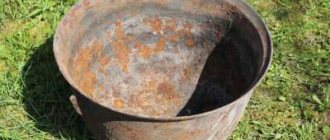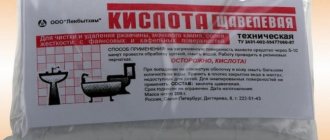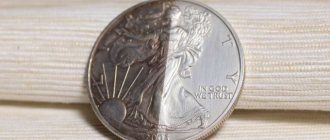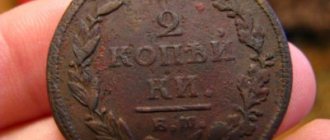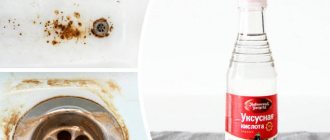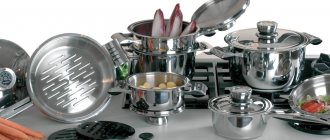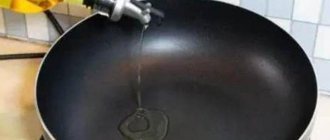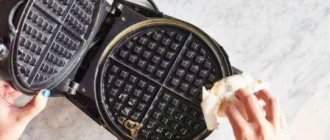It is not uncommon for knives, and other cutlery, to become rusty. As a result, not only the cutting qualities of the products are lost, but their appearance also deteriorates. In addition, using such a knife can be harmful to health, because corrosion particles remain on food.
In our article with video, we will tell you in detail how to get rid of this unpleasant phenomenon, as well as prevent its occurrence in the future by properly caring for your cutlery.
Anti-corrosion agent with zinc
It is sold in spray bottles and has no worse effect on corrosion than acid solutions.
- Before treating with the product, walk over the surface of the knife with iron wool or fine-grained sandpaper.
- Rinse with running water.
- Degrease with an alcohol solution. This creates an optimal environment for the interaction of zinc with metal, during which rust is removed from the knife.
- Use plastic or glass containers for long-term soaking if the surface of the blade is deeply damaged.
- For small stains, apply two coats with a spray bottle (you can use a brush). The first layer is a primer. It dries in 5 – 10 minutes. The second one is applied next.
- Remains of rust from the knife are removed with a scraper.
Stainless steel
While the chromium oxide coating on stainless steel sinks and countertops makes them more resistant to rust than traditional steel, the coating itself is not. Over time, it can wear off, after which rust spots appear even on stainless steel. Luckily, regular baking soda can remove rust stains from stainless metal; Its mild abrasive properties and alkaline pH allow it to remove stains and neutralize any acids on the steel surface that could cause rust.
To remove small rust stains on stainless steel, use a soft, clean cloth to apply the mixture - mix one tablespoon of baking soda and two cups of water, and then apply the prepared paste to the painted area of the steel. Then wipe off the paste with a damp paper towel.
To remove larger rust stains, apply a small ball of baking soda mixture to the selected area and leave it there for up to one hour. You can then gently rub the baking soda into the stain using a soft-bristled brush. Wipe everything down with a damp paper towel and then dry it and watch your stainless steel sparkle!
Measures to prevent corrosion
They say that in order for a knife blade not to rust, it must be used more often. This expression is not without meaning. A knife that is in constant use is regularly wiped, processed, and is in plain sight. Meanwhile, a stored and not used copy is no less at risk of damage by corrosion. If you forget about it for a while and do not treat and clean the metal parts, it will almost certainly rust. The fact is that moisture is found everywhere, including in the air. Gradually settling on the surface of the blade, it will inevitably lead to the process of iron oxidation. Protective compounds, by the way, cannot retain their qualities indefinitely; they must be periodically removed, the knife cleaned and reapplied.
Many owners of professional and hunting knives avoid preventative oil treatment. It is believed that oil can enter into additional interactions with various substances and harm steel. In this case, wax has proven itself to be a more reliable remedy. In addition, a knife that is used occasionally should not be stored in a case or sheath. Any unfavorable conditions, primarily air humidity, in such a cramped space will worsen, and the damage process will accelerate. In addition, you can miss the beginning of the process by simply not seeing it. It is better to sheath the knife when it comes time to take it with you on a trip, hunting, etc.
With the right approach and sufficient attention to the subject, corrosion can be avoided. It is better to spend time preventing a problem than fighting it. Removing rust and preventing its occurrence is a painstaking process that requires regularity. However, perhaps this is one of the few cases when caring for a thing is enjoyable and has a calming effect. The smooth, polished surface of a knife is the owner’s best reward for his efforts.
What can't be used and why?
Do not use too aggressive preparations to clean the blade and mechanism of the knife . If you have doubts about the product, before use it is recommended to apply one drop to the edge of the product to track the reaction and see the result.
GOI paste should be used with great care for polishing. It gets stuck in the smallest cracks and cavities, from where it is difficult to remove.
This is especially true for antique knives that have carved steel handles. It is better to entrust the cleaning of such items to specialists.
Chemical methods of removal
Chemical methods for removing rust are among the most effective. Below we will discuss the most common options for cleaning surfaces from corrosion.
Sulfuric or hydrochloric acid
These anti-rust products for metal are used in combination with inhibitors. To remove traces of rust, you will need an aqueous solution of acid and methenamine as an inhibitor. Without methenamine, it is unacceptable to use such aggressive reagents - the metal can be destroyed under the influence of acids, and the product will be damaged.
To remove corrosion from the surface of small metal parts, they can be immersed in a mixture of a 5% solution of hydrochloric or sulfuric acid and methenamine at the rate of 500 mg per 1 liter of water. Large objects are treated with the same composition using a wide brush. You can remove rust stains from a white fabric item using 2% hydrochloric acid. To do this, immerse the product in an acid solution and leave until the red stain completely disappears. Then the item is removed and rinsed in a weak solution of ammonia. To prepare it, take 3 tablespoons of alcohol per 1 liter of water.
Potato tops can be used as an inhibitor. To prepare the composition, you need to fill a three-liter container halfway with tops and add hydrochloric acid so that it covers the stems. The contents of the jar are constantly stirred for 20 minutes, then the liquid is drained and the damaged surfaces are treated.
Oxalic acid
When working with oxalic acid, you must follow safety precautions - use safety glasses and thick rubber gloves. It is also advisable to use a respirator, since the vapors of this substance are very toxic. To begin with, the rusted part is washed with warm water and detergent and dried thoroughly. Dissolve 6 teaspoons of oxalic acid in 300 ml of water and immerse a rusty object in the resulting solution for half an hour. The remaining plaque is removed with a brush. After processing, the item is thoroughly washed and dried.
Phosphoric acid
Using a metal rust remover, you can turn a layer of corrosion into a thick coating. To do this, use acid with a concentration of 15 or 30%. It is applied to damaged metal products using a spray and left in the open air until completely dry.
For greater efficiency, 1 liter of phosphoric acid must be mixed with 5 ml of butanol and 15 ml of tartaric acid. As a result of processing, a durable protective film of iron phosphate is formed.
Lactic acid
If the item is severely corroded, you can treat it with a mixture of 50 ml of lactic acid and 100 g of liquid paraffin or petroleum jelly. Under the influence of acid, rust turns into salt, which dissolves well in paraffin. Next, wipe the cleaned surface with a napkin soaked in Vaseline oil.
Zinc chloride
In 100 ml of water, 5 g of this substance is mixed with 0.5 g of cream of tartar. Under the influence of the acidic environment created by zinc chloride, rust will easily dissolve.
Lemon acid
Citric acid powder is poured into a plastic container and filled with hot water. The rusted product is immersed in the resulting solution and left overnight. If the solution is prepared correctly, the liquid will begin to bubble and hiss when it comes into contact with the rusted surface. In the morning, the product is removed from the solution, washed with clean running water and dried thoroughly.
Preventive actions
Naturally, removing rust from a metal surface is much more difficult than taking care in advance to prevent it from appearing. There are many tips from professionals that will help prevent corrosion on metal surfaces.
For example, to protect carpentry tools, lubricate them with a solution based on paraffin (wax) and gasoline. Moreover, for 20 grams of paraffin or wax, take 40 ml of gasoline.
Gasoline is heated in a water bath, paraffin or wax dissolves in it. The product is then used for application. It is strictly forbidden to heat it over an open fire.
And polished metal-based tools can be protected from corrosion with a similar composition. In this case, 10 g of wax or paraffin is taken per 30 ml of kerosene and the mixture is applied to the product.
Many products used to remove rust from metal surfaces include aggressive and toxic components. If handled improperly, there is a risk of getting burns to the skin or mucous membranes. It is recommended that after finishing work, do not forget to treat the products with kerosene or gasoline for prevention.
As you can see, there are many ways to solve the problem of how to remove rust from metal. If you find it difficult to tolerate contact with chemicals, you can use more gentle or natural compounds, but they are only relevant for minor corrosion.
Rough cleaning of a knife from rust
A rusty blade can be sanded
Before starting work, you should assess the degree of damage: how much the steel has oxidized and what is the surface area affected by rust. Rough cleaning makes sense when there is severe oxidation. Using tools you can only get rid of the top layer of rust. Remaining deposits will have to be removed using cleaning agents.
Mechanical work is carried out according to the general scheme:
First, the oxidized metal must be prepared and softened. To do this, use non-aggressive means, for example, kerosene or white vinegar. The reagent is poured into a mug and a rusty knife is kept in it for 10 - 15 minutes. Then you can start cleaning. If the layer of dirt is thick enough, you will have to use a chisel with a small hammer or similar tools. You should beat it carefully, trying not to damage the metal. Any remaining oxidation particles should be sanded off with sandpaper. A metal brush, sold in a hardware supermarket, is also suitable for removal. It is not recommended to use sandpaper if the deformed layer of iron is too thin
Such cleaning inevitably causes scratches, which in turn accelerates corrosion processes. If there is severe contamination by deposits, electronic devices will help, the hydrolysis method is the combined use of a solution with reagents and a device that passes current through it. At the last stage, it is important to ensure that there is no dust or particles of abraded deposits. If they remain, corrosion will appear and grow again.
If done correctly, the knife will look like new.
Sharpening
We sharpen the knife on water stones of various grain sizes, pre-soaked for 3-5 minutes, starting from 220, if the knife was very dull. Using a 800 stone we smooth out any traces that could have been left by a 220 stone.
After the first preliminary sharpening on a stone, rinse the knife blade generously with running water so that larger abrasive particles do not remain and damage the sharpening on a finer-grained stone.
Using stones 3000 and 8000, we sharpen, in particular, the cutting edge almost to the tip of the blade.
Bathtub cleaning
Sometimes it is necessary to remove rust from non-metallic objects that are not very convenient to process using the methods listed above. Rusty stains may form on the surface of plumbing products. To clean the bathtub from rust, you can use a wide range of special products, which are currently widely represented on the Russian market (Sanox, Phenolux, Akrilan). Using a brush or sponge, apply the product to the surface and leave for 5 minutes, sometimes longer. Then rinse off while scrubbing the bath with a brush.
There are also traditional means of removing rust in the bathroom at home. Simple ingredients such as soda, salt, and vinegar can act as a rust remover. One method recommends applying equal proportions of soda ash and baking soda to the surface of the bathtub, then spraying it with a mixture of bleach and table vinegar. After 30 minutes, clean with a sponge and rinse with water.
Another method requires adding salt to acetic acid and heating it all in the microwave. Then moisten a napkin with this mixture and wipe the bath. After 20 minutes, wash off with water. There is also a method in which ammonia and hydrogen peroxide are mixed in a 2:1 ratio and then the resulting solution is applied to the enamel surface for 20 minutes and then washed off.
To clean the toilet from rust, use industrial products specially designed for this problem: Komet, Sorti, Pemolux, Sanita. These are abrasive products. You can use alkali-based products: Dosya and Domestos. These substances do not injure the surface of the toilet bowl and do not require much physical effort: after applying the product to the area, leave it for 15-20 minutes and then wash it off. Comet and toilet duck contain acids.
Additional Tips
You can use any suitable method to remove rust marks from a knife. When choosing a product, you should focus on the degree of contamination, financial costs and the possibility of using the method.
In any case, it is advisable to take into account additional recommendations that will facilitate the cleaning process and help speed it up:
If the rusty coating is significant and has not disappeared completely after the first treatment, it is necessary to repeat the cleansing with the same product or choose a different one.- If the corrosion process has gone far and a solid, dense coating of rust has formed on the knife, then it is advisable to first remove it mechanically (with sandpaper), and then complete the cleaning with any liquid agent.
- When using any chemical reagents, it is necessary to wear rubber gloves to protect your skin.
- After complete removal of rusty traces, the blade is thoroughly washed with water and dried well. The presence of moisture can reinitiate corrosion.
Removing rust using electrolysis
The method is effective, but dangerous. Therefore, it should be used only in the most necessary cases, if rust cannot be dealt with using folk remedies and special chemicals.
To remove corrosion, proceed as follows:
- Fill a plastic container with warm water.
- Add 2 tbsp. l. soda or salt.
- Get a car battery charger.
- Attach a metal plate to one wire, and a corroded object to the other.
- Place both ends in the container and turn on the device for half an hour, setting the current to 4–6 amperes.
- Remove any remaining rust with a brush or sponge.
Cleaning using folk remedies
If you don’t want to struggle with mechanical rust removal, you can use proven folk methods.
Acetic acid
It is better to use 70% acetic acid. Then the result will be more noticeable. If there is little rust, then sometimes regular 9% table vinegar is enough.
To remove corrosion and “time deposits” you need to follow a few simple steps:
- Pour the required amount of acetic acid into a deep container so that it completely covers the instrument.
Healthy! For this processing, it is best to use a plastic container that closes tightly with a lid.
- Place rusty products in a container and cover everything with a lid.
Screenshot of a video from the ARS Pro channel https://www.youtube.com/watch?v=0E6kY9JMggE
Tools should be left in this condition for several days (the duration of cleaning depends on the intensity of the contamination). After this you can open the lid. The peeling rust will be clearly visible underneath.
Important! After cleaning the parts with vinegar, you need to rinse the tools in a baking soda solution to remove the acidity
Citric acid and hydrogen peroxide
For 100 ml of water you will need 20 g of citric acid (two packs) and 10-15 ml of peroxide. If you add more citric acid, you will get a more concentrated composition, which is also acceptable.
Healthy! Citric acid without hydrogen peroxide is also effective against old rust.
Screenshot of a video from the OnlyKit channel. https://www.youtube.com/watch?v=0kKy9fpvo1Y
The cleaning procedure is very simple. First, mix the composition in a container and place the tool in it. After this, we leave everything to soak for 24 hours (however, the first result is visible after just a few hours). The liquid becomes dark and the amount of rust decreases.
The main advantage of this method is that the used solution does not need to be thrown away. It is enough to strain it through cheesecloth or cotton cloth and use it for other old tools.
Screenshot of a video from the OnlyKit channel. https://www.youtube.com/watch?v=0kKy9fpvo1YHealthy! It is advisable to purchase hydrogen peroxide with a high percentage of the active substance. However, 3% peroxide will be enough to remove rust.
Coca-Cola
This carbonated drink is used by many to clean stoves, kettle deposits, and much more. Coca-Cola is also suitable for small tools, screws, and dies. Cleaning is very simple:
- Pour Cola into a container (for example, a glass jar).
Screenshot of a video from the channel Man with Hands https://www.youtube.com/watch?v=vqZDA7SmMQE
- Place the rusted part in the liquid.
- Close the lid.
- Leave it for a day.
Lemons
To clean, just cut a few lemons and squeeze the juice into a container. After that, we lower the part into it. All that remains is to close the container with a lid and wait a day.
If we talk about the effectiveness of lemon and Coca-Cola, then the carbonated drink will only cope with very fresh rust. Lemon is the most effective, but getting enough lemon juice to clean a hammer or other large tool can cost a lot of money. It is much cheaper to buy citric acid.
Screenshot of a video from the channel Man with Hands https://www.youtube.com/watch?v=vqZDA7SmMQE
Sulfuric acid
This substance copes well with oxidation. However, before using such a product, you need to dissolve sulfuric acid in water so that its density is 1.15 g/cm3
This is an important condition, since with an increased concentration of the substance, not only corrosion will be destroyed, but also the metal itself
Important! You can work with sulfuric acid only in protective gloves, goggles and a respirator. After preparing the solution of the required density, it is enough to dip the part in it for 20-30 minutes
After this, you need to thoroughly clean and rinse the instrument.
After preparing the solution of the required density, it is enough to dip the part in it for 20-30 minutes. After this, you need to thoroughly clean and rinse the instrument.
Old, dried out
Traces of blood that have already dried will be much more difficult to remove. If the recipe you are using does not help, you can use another one.
It is advisable to start processing by soaking the entire item in cold water. This technique will prepare the fabric for further processing.
For relatively fresh stains, it is enough to keep the clothes in water for an hour, for old traces of blood (if the type of fabric allows) - longer, 2-3 hours.
If, after soaping with Antipyatin or laundry soap, the stain does not go away completely, proceed to removing the marks using one of the recipes.
Dishwashing gel
Shampoo or dish soap can be used to remove stains if nothing else is available and the stain is not yet old.
To do this, moisten the material, apply the selected preparation and rub gently. After 10 minutes, wash and rinse the item.
Another way is to apply undiluted dishwashing gel directly to the stained area of the material. Apply liberally, not in a thin layer.
After this, cling film is placed on top and left in this form for a couple of hours or even more, up to five. After this, the product is washed.
Hydrogen peroxide
White items can be treated with hydrogen peroxide, but only if the material is natural (cotton, linen) and dense.
Stain removal procedure:
- Use a bottle of peroxide to pour over the stain. Or treat it using a sponge.
- Allow time for the chemical reaction to take place.
- Wash the item.
You can enhance the effect if you add ammonia to the peroxide. These liquids should be combined in equal proportions.
This method is only suitable for fairly dense fabrics and is not recommended for delicate ones.
Salt
To remove a stain, you need to prepare a solution:
- pour 3 liters of cold water into a basin;
- add 60 grams of salt;
- stir;
- dip soiled clothes;
- leave for 6-8 hours;
- wash with Antipyatin or laundry soap;
- rinse.
For delicate fabrics, the option with salt is undesirable.
Soda
Removing stains with soda is carried out according to the following method:
- Pour 1 glass of cold water into a container.
- Pour 10-15 grams of soda into it.
- Stir.
- Pour the solution onto the mark.
- Leave for 30 minutes.
- Rub the dirty area.
- Wash the item using detergent.
The recipe is designed for thick fabric.
Ammonia
Ammonia allows you to remove blood from clothes, sheets and other soiled items made from linen or cotton.
Procedure:
- pour 3 liters of water into a basin;
- pour in 60 ml. ammonia;
- soak the thing;
- keep in the solution for a couple of hours.
Potato starch
For thick cotton and linen fabrics, you can use almost any of the recipes, but for delicate items you need to proceed differently:
- Pour ½ cup of starch into a container.
- Add a little water to form a paste.
- Apply the mixture to the fabric.
- Set the item aside for the time necessary for the paste to dry completely.
- Clean any remaining slurry from the material with a dry cloth or towel.
- Wash the product.
Vinegar
Table vinegar, thanks to the acid it contains, can be a good stain remover. A local stain can be treated with undiluted liquid and left for half an hour.
If there are several stains in different places, it would be better to prepare a solution of two parts water and one part vinegar. The item is completely dipped into it and left for 10-15 minutes, after which it is washed.
For vinegar to be 100% effective and completely remove stains, it should be used within the first 24 hours after the mark is formed. After this period, acetic acid will be less effective.
Glycerol
Glycerin is often used to remove stains. For the best effect of the manipulation, the bottle with glycerin should be warmed up a little so that it becomes warm.
Using a cotton swab, treat the blood stain while the glycerin is still warm. After removing the stains, the item is washed and rinsed.
Lemon and salt
Lemon juice is a natural product that helps in removing a variety of stains. Citric acid, like acetic acid, can also cope with blood stains.
For cleaning, prepare the following mixture:
- in a container mix 2 tbsp. l. lemon juice and 1 tbsp. l. salt;
- Using an old toothbrush, treat the fabric;
- Rinse the material with cold water.
The disadvantage of this method is its relatively low effectiveness against large or old stains. And the impossibility of using on colored fabrics.
The process of removing rust from metal at home.
After cleaning the metal objects from loose rust with a brush, I placed them in a plastic tray. It took 2.5 liters of water to cover them completely. For this amount I poured 200 grams of lemon. Then I stirred it until completely dissolved, immersed our “test subjects” again and left the solution to “work.” I placed the second sleeve vertically specifically so that later I could show the result as in a toothpaste advertisement: “we will spread the right side of the egg with regular toothpaste, and the left side .....”))).
The citric acid solution gradually eats away the rust layer by layer. To ensure access of the acid to subsequent layers, after 2-3 hours I take out all the objects and clean off the corroded layers with a wire brush. It takes no more than 5 minutes, but the result is much better. Then every hour I repeat this procedure 3-4 more times. The photo shows cleaning the ax after 2 hours in the solution. As you can see, the effect of the solution for removing rust from metal is already visible to the naked eye.
It is necessary to clean off the corroded layer only for deeply ingrained rust. The key lay in the open air for several months, so the rust did not have time to eat as deeply as into the ax or the sleeve. It only took him 2 hours to completely get rid of the rust. The result can be seen in the photo. I took out the key, and the rest of the items continued to lie in the solution.
After a day, the transparent solution accumulated a large amount of corroded rust and became very cloudy. Now we clean all the items again with a metal brush from rust residues, wash them in a solution and look at the result.
How to protect a blade from corrosion: prevention
Always dry your knife after use
To prevent the knife from becoming rusty, you need to be careful when storing it. The oxidation process occurs as a result of exposure to moisture on the metal, as well as due to some trace elements remaining on the surface of the blade.
To reduce the rate of deformation, it is necessary to ensure careful operation:
After use, the blade should be washed and dried with a towel.
Firstly, this will remove food residues on which microbes settle, accelerating the chemical reaction; secondly, it will reduce the rate of oxidation due to the removal of moisture. If the gun is stored in a case, it is important to prevent moisture and dirt from accumulating inside the case. When the blade is not planned to be used, it is carefully preserved. The tool in use is constantly exposed to friction processes
It is washable, wipeable, and does not sit for a long time, so carbon steel does not rust so quickly. For preservation, it is better to use wax rather than oil. The latter reacts with any steel, even Damascus, and can damage it. It is not recommended to keep knives near the sink, stove or radiators. Steel is adversely affected by high humidity or excessively warm air.
The formation of corrosion over time is a natural process: it is caused by various chips and microcracks on the surface. Therefore, during operation, you should try to avoid mechanical damage to the tool.
You can also use a folk remedy to prevent the defect:
- Mix lactic acid in a 2:1 ratio with petroleum jelly.
- Apply the mixture to the blade in a thin layer.
- Leave the knife in a place away from direct sunlight for 10 minutes.
- Gently wipe off the composition with a dry cloth.
After this treatment, the blade can be stored for a long time without fear of corrosion.
By ensuring your knife is stored properly, you will protect it from rust, and then you will not have to use radical methods to clean it.
Using Alternative Methods
One way - already mentioned earlier - is to remove rust using potatoes. Everything is simple here. To remove traces of corrosion from a knife, you need to stick it into a potato and leave it there for a day. Then remove the tool and wipe it with a rough cloth soaked in oil. In less advanced cases, this is a fairly effective remedy. The oxalic acid contained in potatoes reacts with iron hydroxide, neutralizing it. The process of cleaning steel from rust using onions proceeds in the same way. In this case, onion juice is applied to the blade and left for several hours, after which it should be removed along with the exfoliated rust.
You can remove rust stains in the same way using lemon juice or vinegar; you can even use ketchup for this. The principle of operation is identical to that described above. Some people successfully solve this problem with sparkling water. There is an opinion that Coca-Cola is especially suitable for these purposes, since it contains phosphoric acid. It is necessary to immerse the knife in a container with a drink for several hours, then remove it and remove the rust with a wire brush or washcloth. Finally, polish the blade and protect it from moisture using oil, wax or special products.
When fighting rust, sometimes the most unexpected things are used, for example, Alka-Seltzer or aspirin. Several tablets are dissolved in a small amount of water and a knife blade is dipped into the solution for a quarter of an hour, after which the surface is wiped with a rough cloth and the knife is treated, as in all other cases, in order to protect it from subsequent damage.
What to do with a rusty object and how to remove stains from it, what method to use for this is up to the owner of the knife to decide. Buying a ready-made product is perhaps the safest option, but it’s still worth experimenting with alternative methods, especially if the case is not too advanced. The main thing after this is to prevent rust stains from appearing again, since some of them can be difficult to remove. In this matter, prevention is everything.
